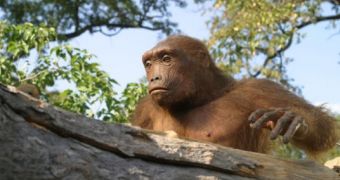When Toumai ("Hope of Life" in the local Goran language) was found in Chad (Africa), that changed all the theories about human evolution. This ape-like human lived 7 million years ago in a forested area, sharing its habitat with other monkeys and apes and always alert to cats, crocodiles and pythons. It spent probably some time in the trees and perhaps walked upright. Anyhow, if we saw one, we would believe it is just a chimp.
But Toumai (Sahelanthropus) lived 1 million years before the oldest known ape-human species known before, Orrorin. And the big surprise it delivered was its finding in an area out of the East African Rift Valley, where the greatest discoveries of the last 35 years in the human evolution have been made, but in the Sahel semidesert, in Chad, 2,500 km (1,550 mi) to the east.
Sahelanthropus shows that the first human ancestors did not live in a savanna, but in a forested area. The paleontologists were surprised to find, in the mix of human and ape traits of Toumai, human traits more modern than expected for such an old creature.
In the same area, researchers had discovered in 1995 a 3.5 million years human ancestor that could have belonged to the same species as the famous Lucy, found in the '70s in the Rifft Valley, Australopithecus afarensis.
The little flattened and eroded, but complete, skull of Toumai was discovered in 2001. The skull could not be easily dated, but at the same site, in the desert of Djurab, were found fossils of fishes, crocodiles, rodents, elephants, giraffes, and aardvarks identical to specimens already dated through radiometric methods.
The age of 6-7 million years means the Toumai could have been the first hominid species or at least one of the first to follow the path towards Homo sapiens. The skull and the brain (320-380 cubic centimeters) were no larger than those of a chimp, but the short, flattened face, pronounced superciliary Arch (unlike in chimps and humans, and pointing the individual was a male), the less pushed forward mouth and jaws (than in the case of the apes) and the smaller, shorter canines, with a worn down tip, show that the creature was not a chimp. The molars are larger than a chimp's, but smaller than in early humans, showing it ate less fruit.
Perhaps the most interesting trait in the Toumai's skull is the foramen magnum, the aperture at the base of the skull, where the spine cord connects to the brain. It has an oval, not round shape like in chimps. Its shape and location points out that Toumai could walk in an upright position. Based on the skull's size, researchers believe the Sahelanthropus was the size of a chimp.
This face looks more modern than that of the A. afarensis, which lived 3.6 to 2.9 million years ago. Still, Ardipithecus ramidus (4.4 million years ago) and Ardipithecus kadabba (5.8 million years ago) are older than Lucy was, and were regarded as our most remote ancestors. The teeth of Ardipithecus are similar to those of Sahelanthropus.
Because of the modern look of Toumai, this means that the Australopithecus are not our ancestors, but a lateral dead branch in our genealogical tree, like the Neanderthals. In this case, Sahelanthropus would have evolved into an intermediary species, still undiscovered, whose descendants would have gave birth to Homo rudolfensis (2.5 to 1.8 million years ago) and Homo habilis (1.9-1.5 million years ago), one of which was the first species of Homo genus.
This means that in our evolution, we have competed with many human-ape species. Like in the case of many species today, we shared our environment with "sister" species. 30-40,000 years ago, when Homo sapiens created paintings inside the caves, the Neanderthals were also an inhabitant species of the planet. Today, there is only one human species, but in other times, there were several at a time on the planet.
The molecular clock shows that humans and chimps split some 4-5 million years ago. In this case, the Sahelanthropus would be a common ancestor for humans and chimps. It could also be anatomically related to both humans and chimpanzees, but the ancestor of neither. Others say that it could be a female belonging to an ancestor of the gorillas. No matter the reality, Toumai shows that the last common ancestor of humans and chimpanzees did not look much like a chimp, as previously thought, and chimps could have evolved many of their traits after splitting from humans.

 14 DAY TRIAL //
14 DAY TRIAL // 
